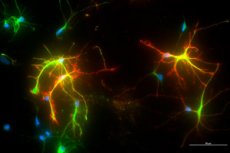Protein-mimicking nanomaterial could treat neurodegenerative diseases
Sist anmeldt: 14.06.2024

Alt iLive-innhold blir gjennomgått med medisin eller faktisk kontrollert for å sikre så mye faktuell nøyaktighet som mulig.
Vi har strenge retningslinjer for innkjøp og kun kobling til anerkjente medieområder, akademiske forskningsinstitusjoner og, når det er mulig, medisinsk peer-evaluerte studier. Merk at tallene i parenteser ([1], [2], etc.) er klikkbare koblinger til disse studiene.
Hvis du føler at noe av innholdet vårt er unøyaktig, utdatert eller ellers tvilsomt, velg det og trykk Ctrl + Enter.

A new nanomaterial that mimics the behavior of proteins could become an effective treatment for Alzheimer's disease and other neurodegenerative diseases. This nanomaterial alters the interaction between two key proteins in brain cells, which may have a powerful therapeutic effect.
The innovative results, recently published in the journal Advanced Materials, were made possible through a collaboration between scientists at the University of Wisconsin-Madison and nanomaterials engineers at Northwestern University.
The work focuses on changing the interaction between two proteins believed to be involved in diseases such as Alzheimer's disease, Parkinson's disease and amyotrophic lateral sclerosis (ALS).
The first protein is called Nrf2, which is a specific type of protein called a transcription factor that turns genes on and off inside cells.
One of the important functions of Nrf2 is its antioxidant effect. Although different neurodegenerative diseases arise from different pathological processes, they are united by the toxic effects of oxidative stress on neurons and other nerve cells. Nrf2 fights this toxic stress in brain cells, helping prevent the development of diseases.
Professor Jeffrey Johnson of the University of Wisconsin-Madison School of Pharmacy, along with his wife Delinda Johnson, a senior scientist at the school, have been studying Nrf2 as a promising target for treating neurodegenerative diseases for decades. In 2022, the Johnsons and their colleagues discovered that increasing Nrf2 activity in a certain type of brain cell, astrocytes, helps protect neurons in mouse models of Alzheimer's, resulting in significant reduce memory loss.
Although previous research suggested that increasing Nrf2 activity could be the basis for treating Alzheimer's disease, scientists have had difficulty effectively targeting this protein in the brain.
"It's hard to get drugs into the brain, but it's also been very difficult to find drugs that activate Nrf2 without a lot of side effects," says Jeffrey Johnson.
And now a new nanomaterial has appeared. Known as a protein-like polymer (PLP), this synthetic material is designed to bind to proteins as if it were a protein itself. This nanoscale simulator was created by a team led by chemistry professor Nathan Giannekshi from Northwestern University and a member of the university's International Institute of Nanotechnology.
Giannecchi has designed several PLPs to target different proteins. This particular PLP is structured to alter the interaction between Nrf2 and another protein called Keap1. The interaction of these proteins, or pathway, is a well-known target for the treatment of many conditions, since Keap1 controls when Nrf2 responds to and combats oxidative stress. Under normal conditions, Keap1 and Nrf2 are bound, but when stressed, Keap1 releases Nrf2 to perform its antioxidant function.
“It was just in the course of conversation that Nathan and his colleagues at Grove Biopharma, a startup focused on therapeutically targeting protein interactions, mentioned to Robert that they were planning to target Nrf2,” Johnson says. "And Robert said, 'If you're going to do this, you might want to call Jeff Johnson.'"
Soon, the Johnsons and Giannenchi were discussing the possibility of providing the University of Wisconsin-Madison lab with the mouse model brain cells needed to test Giannenchi's nanomaterial.
Jeffrey Johnson says he was initially a bit skeptical of the PLP approach, given his unfamiliarity with it and the general difficulty of precisely targeting proteins in brain cells.
"But then one of Nathan's students came here and used it on our cells, and, man, it worked really well," he says. "Then we really dug into it."
The study found that Giannenchi's PLP was highly effective at binding to Keap1, which freed Nrf2 to accumulate in the cell nuclei, enhancing its antioxidant function. Importantly, it did so without causing the unwanted side effects that have plagued other Nrf2 activation strategies.
While this work was done in cells in culture, Johnson and Giannenchi now plan to do similar studies in mouse models of neurodegenerative diseases, an avenue of research they hadn’t expected to pursue but are now excited to pursue.
“We don’t have a background in biomaterials,” says Delinda Johnson. “So getting this from Northwestern and then further developing the biology side here at the University of Wisconsin shows that these types of collaborations are really important.”
